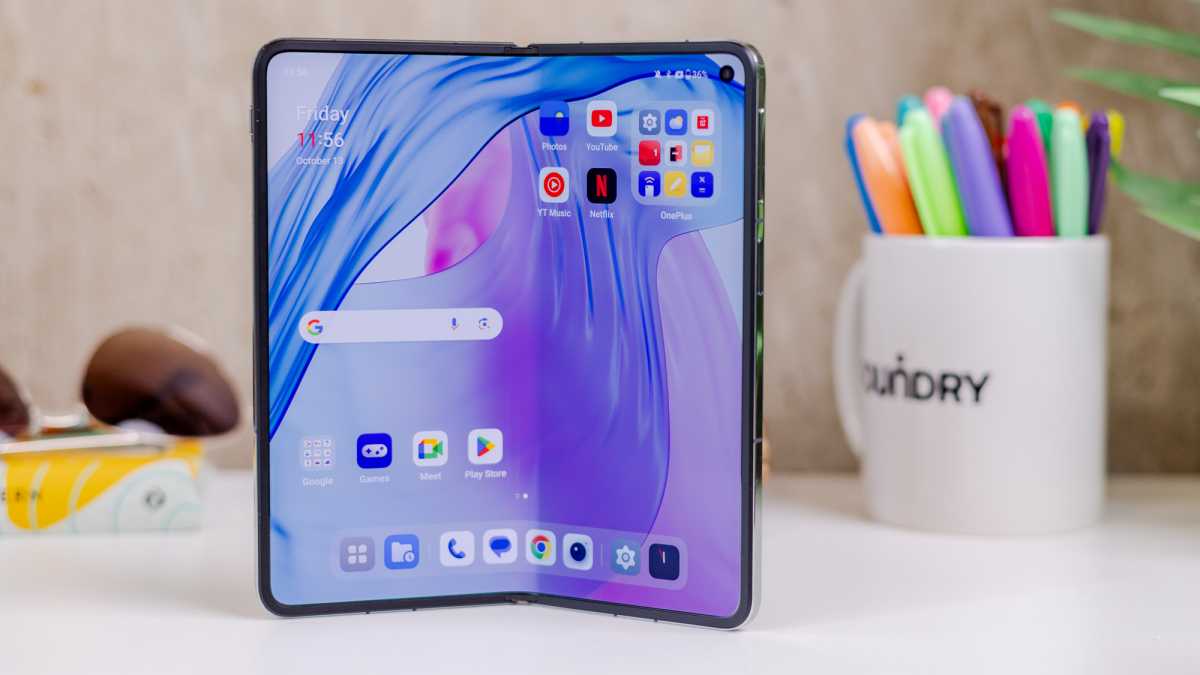Expert’s Rating
Pros
- Excellent displays
- Very good rear cameras
- Intuitive software features
- Premium, durable design
Cons
- Battery life could be better
- Few apps optimised for big screen
- Only splash resistant
Our Verdict
The OnePlus Open is undoubtedly one of the best folding phones you can buy. But it doesn’t quite do enough to convince foldable sceptics that a book-style device is the future.
Price When Reviewed
$1,699
Best Prices Today: OnePlus Open
$1699
We’ve had to wait a while for it, but the OnePlus Open stands out among foldables for a variety of reasons. The first is its name: rather than opting for the tried-and-tested ‘Fold’ branding, OnePlus wants the device to be ‘Open for Everything’, hinting at its versatility as phone-tablet hybrid.
But the same can be said of parent company Oppo’s Find N3, which launched at the same time as the OnePlus Open with near-identical hardware and software. And then there’s the simple fact that it’s taken until 2023 for OnePlus to release a folding phone, making it one of the late comers to the party.
However, none of that matters if the OnePlus Open performs well in the real world. While that’s certainly the case, it isn’t quite the genre-defining device you might be hoping for.
Design & Build
- Premium book-style design
- Impressive durability
- Excellent haptics
If you’ve tried a book-style foldable before, the OnePlus Open will be familiar to you. Its design is in keeping with rivals such as the Galaxy Z Fold 5, with a regular phone-sized cover display (6.31in) that opens to reveal a small tablet (7.82in).
Like Samsung’s latest, the Open folds completely flat, meaning it looks great while open (get it?) or closed. And while you will see and feel the crease on the inner screen, it doesn’t affect usability in any significant way.
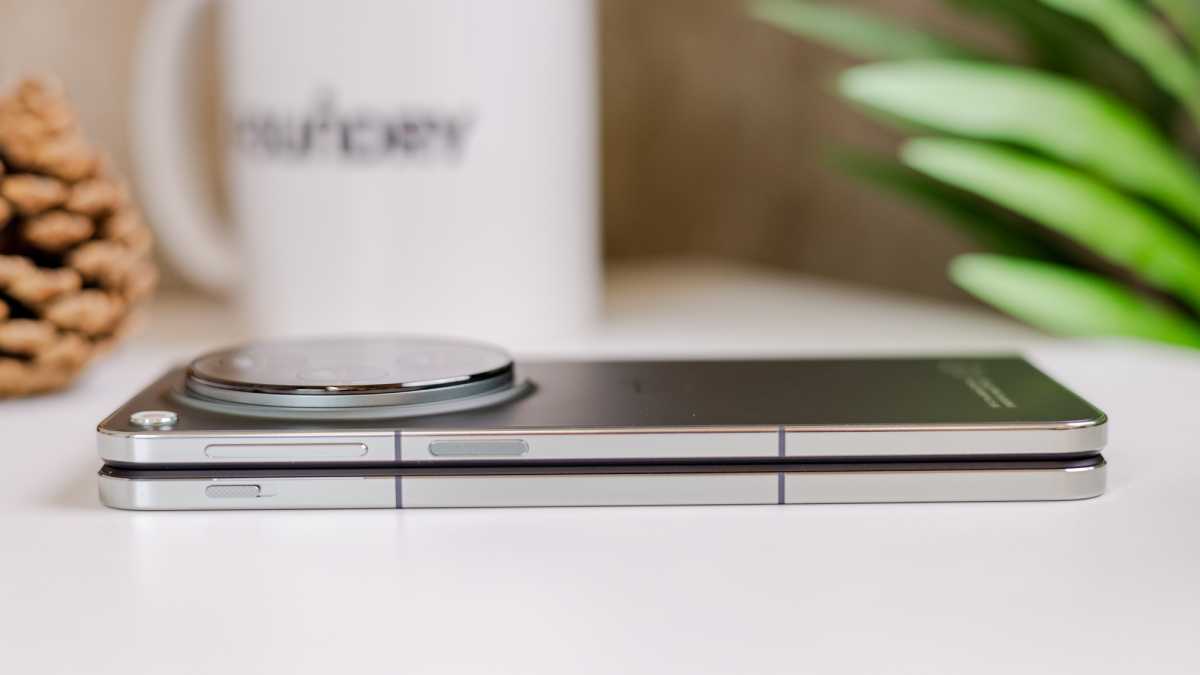
Dominik Tomaszewski / Foundry
But durability will always be the top priority on a folding phone. OnePlus claims the Open can last for over 1,000,000 open and close cycles, equivalent to more than 100 folds every day for over 10 years. Of course, I have no way of verifying that after a week of use, but the hinge certainly feels very tough and robust.
OnePlus has carried out a variety of other testing to verify durability, including exposure to 1m drops onto steel, a force of 55lbs and significant bending. It survived all of these unscathed.
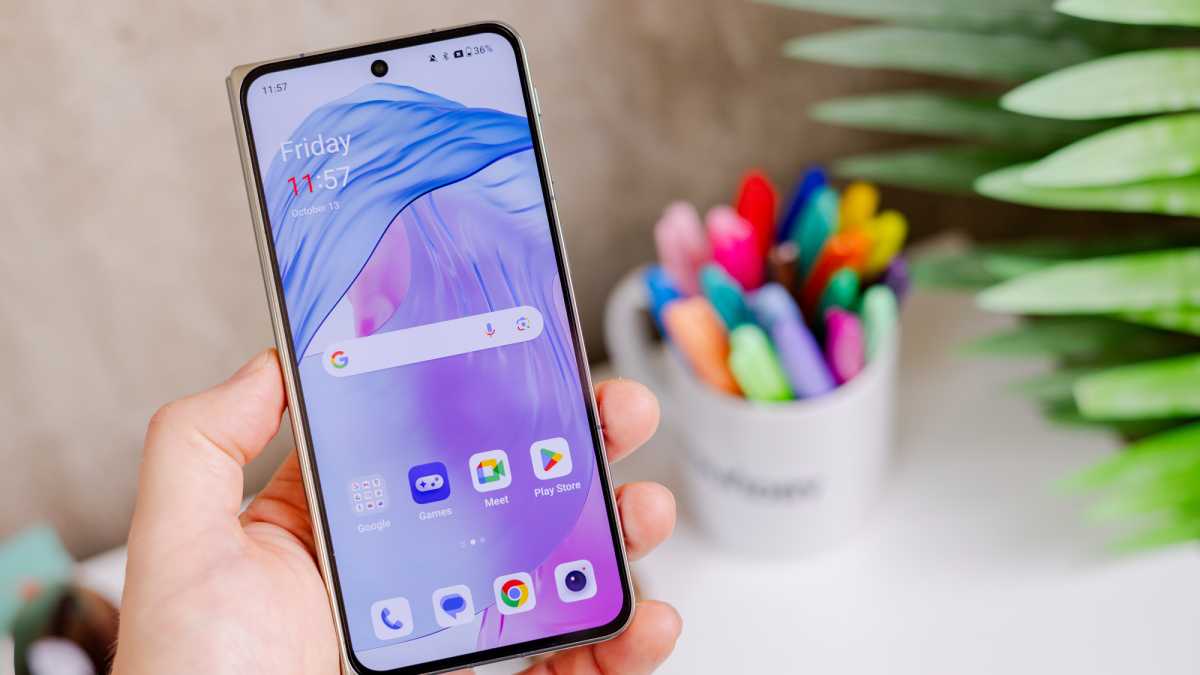
Dominik Tomaszewski / Foundry
However, it’s not clear if that included scratch resistance. Despite using the Open like I would any other phone, the cover screen picked up a couple of significant scratches within a couple of days. This can easily be rectified by removing the pre-applied screen protector, but I wouldn’t recommend it.
Despite potential for some cosmetic damage, nothing else about the Open feels cheap or fragile. Most people shouldn’t have a problem using it for the full five-year duration of security updates, but it’s worth applying a case.
This is a device that’s attractive from every angle
The Open also has an IPX4 rating, meaning it’s not protected against dust and can only survive exposure to splashes of water. It’s not the full 1.5m submersion for 30 minutes of IP68/IPX8. This is very difficult to achieve on a foldable but Samsung has managed it on the IPX8 Galaxy Z Fold 5.
Crucially, the premium aluminium and glass build hasn’t come at a cost to portability. The green model weighs just 245g, which isn’t much heavier than the hefty 234g Galaxy S23 Ultra.
At 11.7mm when folded, it’s also relatively thin, so can easily fit in the pocket of most men’s trousers. This may still be an issue for women, whose pockets tend to be much smaller, but this is by no means unique to the Open.
However, this is a device that’s attractive from every angle, especially in the dark green ‘Emerald Dusk’ finish. The matte-frosted glass back shimmers attractively as it catches the light, but still does a good job of avoiding fingerprints and other visible dirt.
It’s a shame the ‘Voyager Black’ vegan leather version isn’t coming to the UK and Europe, though it is available in the US. This is slightly lighter (239g) and thicker (11.9mm) than the green model, but this grippy back means you can probably go case-free.
Regardless of colour, the defining feature on the back of the phone is that huge circular camera bump. It’s significantly larger than even the OnePlus 11’s, but I quite like it. This rounded theme extends to the corners of the device itself, which makes the Open easier to hold when open or closed.
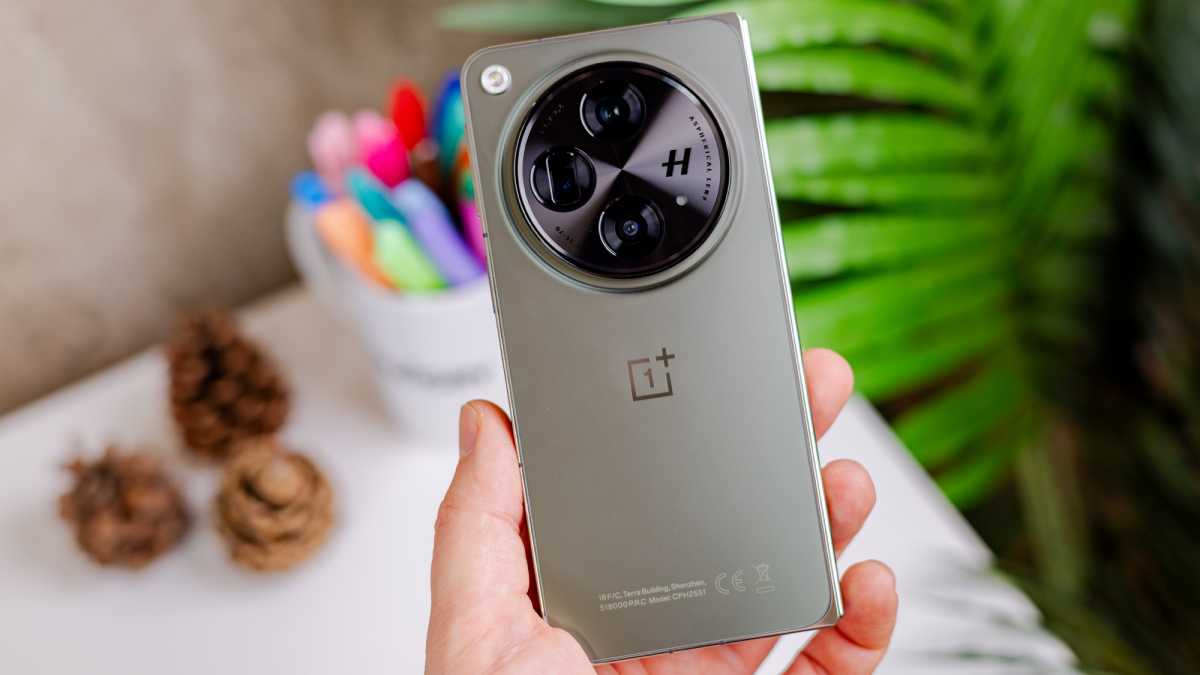
Dominik Tomaszewski / Foundry
I would say that the camera module is unique, but parent company Oppo’s Find N3 looks exactly the same. In fact, the only real difference between the two is OnePlus’ traditional alert slider.
As usual, this allows you to quickly move between ring, vibrate and silent modes. I find it genuinely useful, but it can easily be ignored if you don’t feel the same way.
On the opposite side (when open) is a fingerprint scanner built into the power button. I wish more companies would go for this rather than the often unreliable in-display versions. On the Open, it’s easy to set up and consistently unlocks the device quickly, so I can have no complaints.
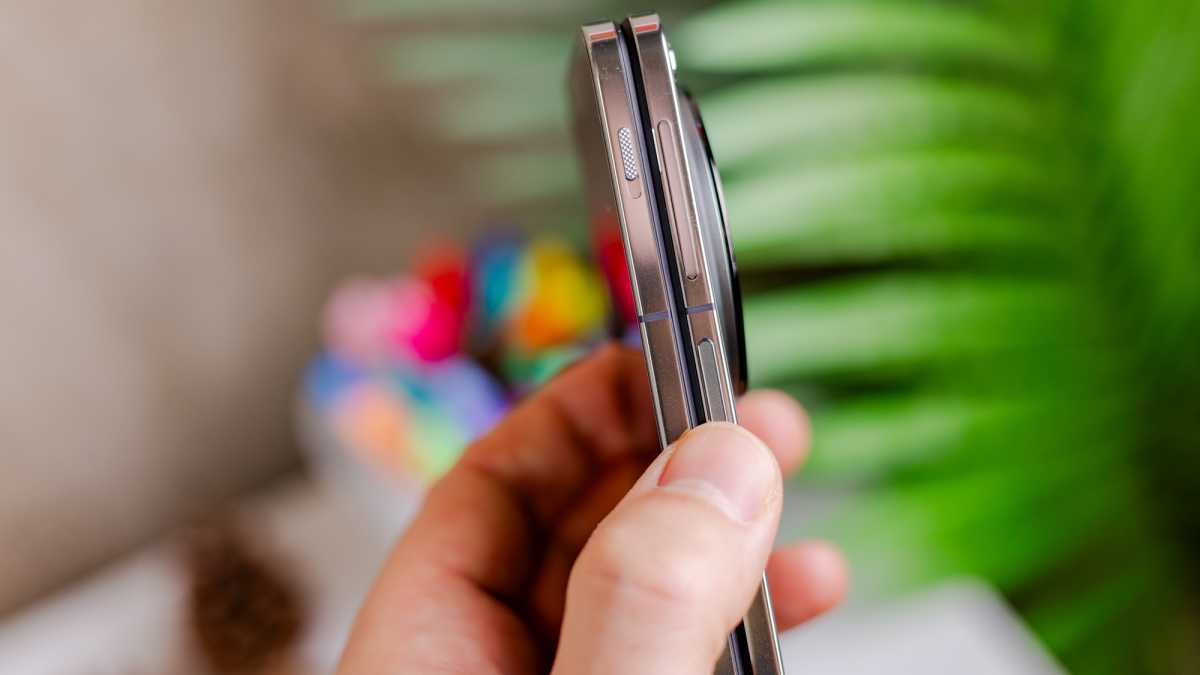
Dominik Tomaszewski / Foundry
It’s also worth highlighting the haptics, which are the best I’ve ever tried. OnePlus has even given them a name – O-Haptics – and they deliver subtle yet realistic feedback across a variety of different scenarios. I initially found the intensity while typing to be too high, but this can easily be adjusted in settings.
Screen & Speakers
- Excellent cover and internal displays
- Not great for content consumption
- Impressive stereo speakers
OnePlus hasn’t spared any expense when it comes to the Open’s displays.
The internal one – the main reason for buying a book-style foldable – is a 7.82in, 2K (2440×2268) OLED panel. And it looks simply superb, combining rich, vibrant colours with plenty of detail. The best smartphones all have excellent displays these days, but I’m glad it’s also possible on one that folds.
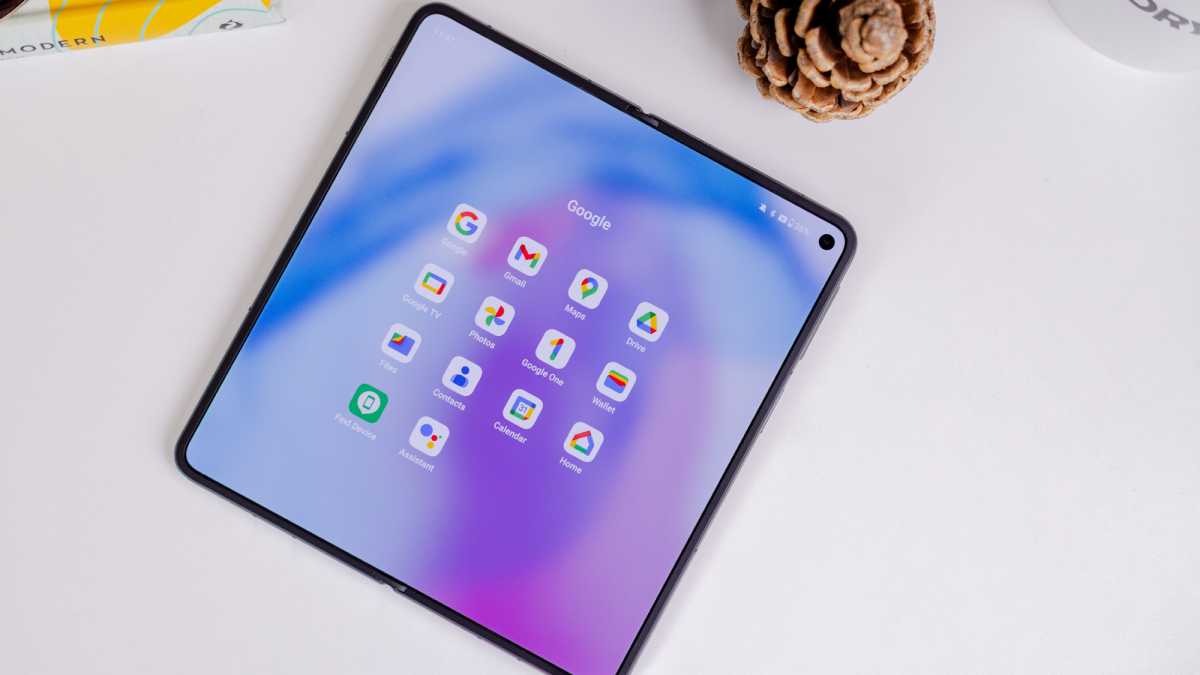
Dominik Tomaszewski / Foundry
Of course, that means there’s a crease all the way down the middle, which you can see and feel when you touch it. Other foldables have done a better job of obscuring it, but I was surprised how little that mattered. I soon forgot the crease was even there, and you can’t see it at all while videos are playing.
But sadly, the latter isn’t a strong point for the OnePlus Open. The unusual resolution gives it a very boxy aspect ratio that doesn’t play nicely with content from the likes of YouTube, Netflix and Disney+. You’ll have to make do with huge back bars above and below, meaning the actual viewing area isn’t much bigger than a regular phone.
OnePlus hasn’t spared any expense when it comes to the Open’s displays
However, I did enjoy using the internal screen for most of my usual tasks, including web browsing, messaging/emails and streaming music. It’s also excellent for multitasking, allowing you to comfortably run two (or more) apps side-by-side.
In all of the situations above, you’ll notice the high refresh rate of the screen. It’s a 120Hz LTPO panel, meaning it can automatically go all the way down to 1Hz depending on what you’re doing. As a result, everything feels slick and fluid, without too much of a hit to battery life.
The 6.31in cover display can only operate between 10-120Hz, but it’s just as impressive. The 2484×1116 OLED has a much more traditional 20:9 aspect ratio, mirroring what we see on many regular phones.
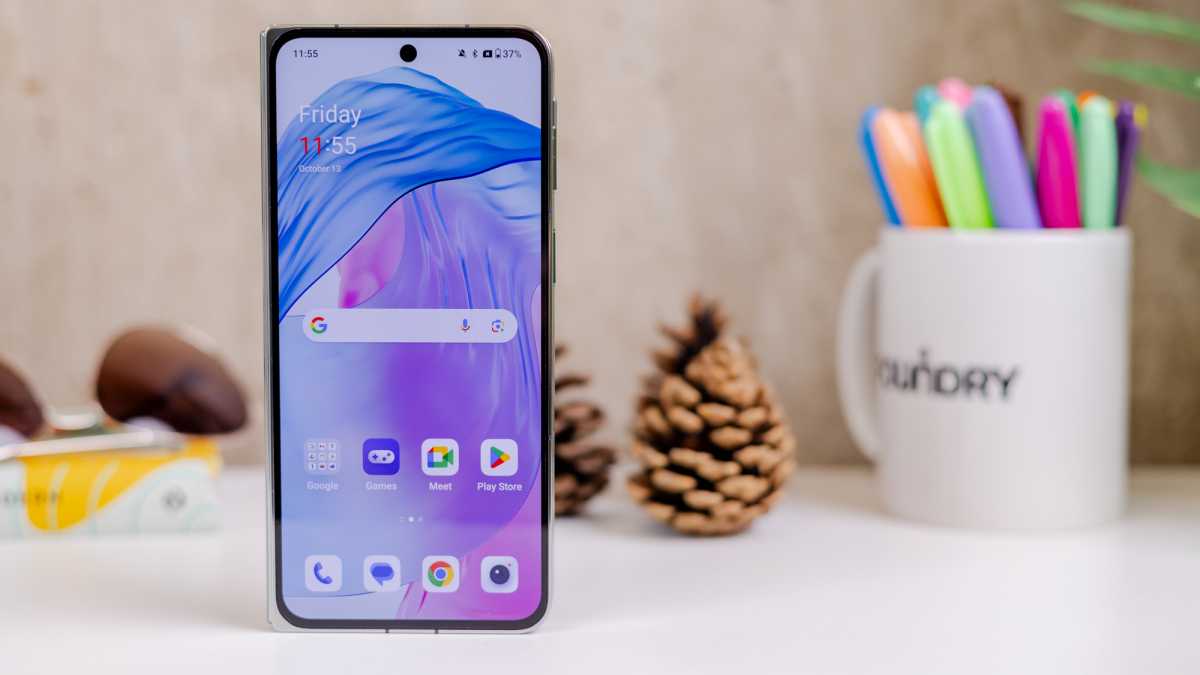
Dominik Tomaszewski / Foundry
But detail and colour accuracy is still top-notch, and I recorded a decent maximum brightness of 579 nits. The internal display is only slightly behind in that regard, and both are clearly visible in bright outdoor environments.
Another thing that really impressed me was how small the bezels are. They’re tiny around the cover display, and about as small as you could expect inside when you need room for a hinge mechanism.
The Open has four speaker grilles, but only three are actual speakers. OnePlus says this is because the bottom right one is more powerful, so one on the bottom left isn’t necessary.
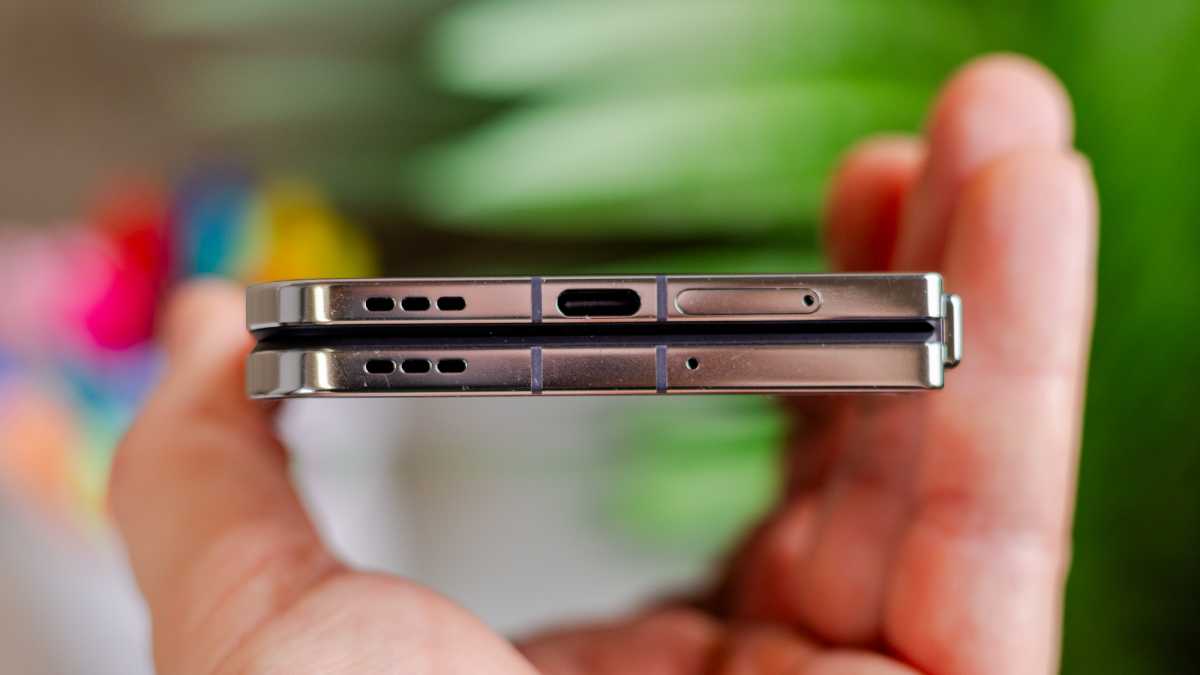
Dominik Tomaszewski / Foundry
I can’t verify that, but the stereo sound they can produce is better than you might expect. There’s an impressive depth and detail to the audio, whether you’re listening to voices, music or other sounds.
Bass and treble are obvious weaknesses, but they handle mid-range frequencies very well. They’re fine for both casual use and watching movies & TV shows, albeit not as impressive as dedicated tablets such as the OnePlus Pad.
Specs & Performance
- Snapdragon 8 Gen 2 and 16GB of RAM
- Stellar performance in all scenarios
- 512GB non-expandable storage
The Open is powered by the Snapdragon 8 Gen 2 chip, Qualcomm’s latest and greatest at the time of launch. Despite the announcement of a successor (the Snapdragon 8 Gen 3) just a few days later, there was no need for OnePlus to wait.
That’s because the 8 Gen 2 still delivers all the performance you need and then some. Alongside 16GB of the fastest LPDDR5X RAM, it’s supremely fast across almost any task. OnePlus says the RAM can be expanded up to an additional 12GB, but it hasn’t said how.
I used the Open for everything I’d typically use my phone for, from web browsing and scrolling social media to messaging and taking photos. The only slowdown of any description was a couple of slight hesitations when opening apps, but I think that’s related to software, and I haven’t experienced it since installing a recent update.
Multitasking, one of the key strengths of the Open, was also very fast and reliable. OnePlus claims you can run a staggering 44 apps simultaneously, and from testing the device I can see why.
The top-tier performance also makes the Open a potent gaming machine
The top-tier performance also makes the Open a potent gaming machine. While playing demanding titles such as Call of Duty: Mobile, Asphalt 9 and Rocket League Sideswipe, gameplay remained smooth and lag-free throughout.
They also handled the unusual aspect ratio on the inner display well, so I’d argue the experience here is even better than on dedicated gaming phones for short gaming sessions. However, longer sessions are where you’ll miss the more advanced cooling systems on those handsets.
OnePlus Open benchmarks
There’s only one storage option, but 512GB will be plenty for most people. I barely made a dent in this during my testing time, though the lack of support for microSD expansion is a shame.
But the Open is well future-proofed when it comes to connectivity. Alongside 5G, you also get Bluetooth 5.3 and Wi-Fi 7 support. The latter is yet to fully roll out, but it’s nice to know you’ll be able to get the fastest speeds.
Cameras & Video
- Impressive triple rear cameras
- Average front-facing cameras
- Super-stable 1080p video
The OnePlus Open has a total of five camera lenses in three locations. But the triple rear setup, designed in collaboration with camera company Hasselblad, is undoubtedly the most important.
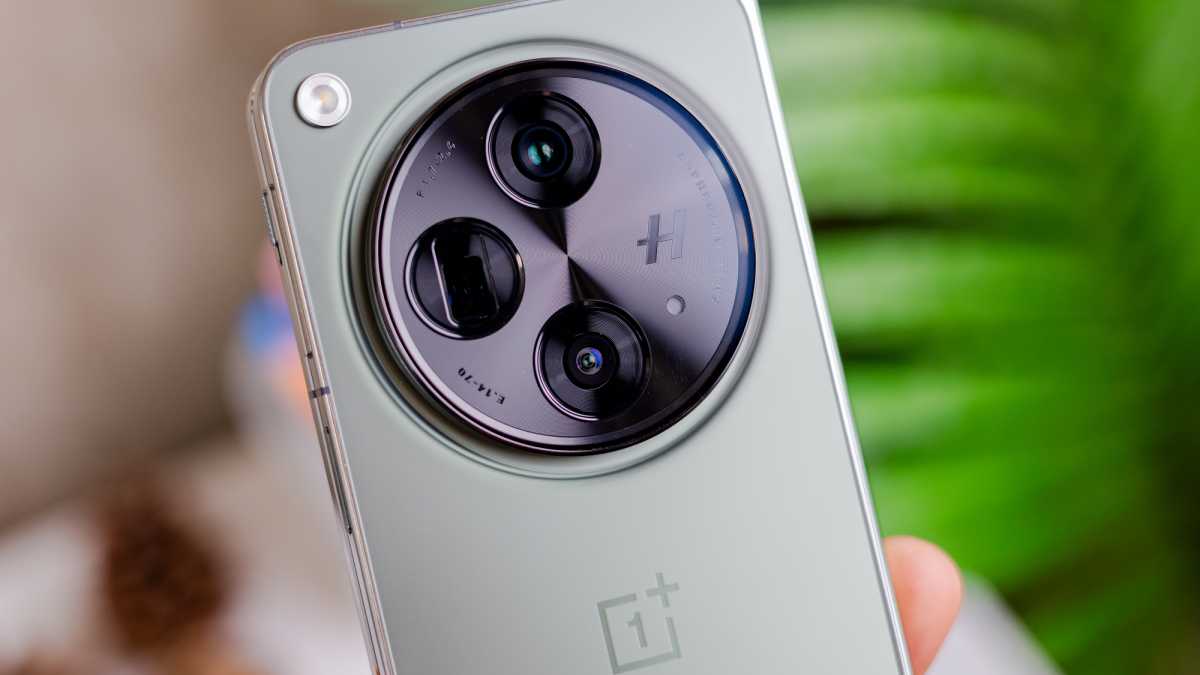
Dominik Tomaszewski / Foundry
It’s led by a 48Mp Sony LYT-T808 main sensor, which can produce consistently great shots in good lighting. Detail and dynamic range from the main lens are superb, and it handles exposure very well.
Colours are generally true to life, rather than the highly saturated look we get on some smartphones. But I personally prefer this, as it feels authentic and can easily be edited afterwards. It’s still a great point-and-shoot camera though – many photos don’t need anything done to them.
Detail and dynamic range from the main lens are superb, and it handles exposure very well
In general, the Open fares better when there are clear subjects in the frame. I particularly enjoyed the shots it took of architecture, with the 48Mp ultrawide better suited to landscape photography. Unlike many camera phones, the quality of images is only a small step down compared to the main lens, and the 114-degree field of view often comes in handy.
But the 64Mp telephoto is arguably the most impressive of the lot. It supports optical zoom up to 3x, while the digital version goes all the way up to 120x. It’s the hybrid of optical and digital at 6x that delivers some of the best zoom photos I’ve…
